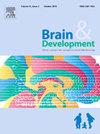关注自闭症谱系障碍儿童的癫痫和癫痫综合征:74例患者的研究
IF 1.3
4区 医学
Q4 CLINICAL NEUROLOGY
引用次数: 0
摘要
癫痫是自闭症谱系障碍(ASD)儿童的常见症状,但很少有研究描述这些儿童的癫痫特征。我们的研究旨在通过一项回顾性的多中心研究来描述ASD和癫痫儿童的电临床特征。材料和方法纳入了9个儿科神经内科的ASD患者,这些患者随后发展为癫痫。排除发育性和癫痫性脑病(DEE)患者、慢性神经系统疾病伴癫痫并发自闭症患者以及非癫痫性发作性疾病患者。结果共纳入74例患者,占2015 - 2023年间494例ASD患儿的15%;其中女性39例(52.7%),男性35例(47.3%)。局灶性癫痫43例(58.1%),其中非自限性24例,自限性19例。全身性癫痫19例(25.7%),其中单纯全身性强直阵挛发作6例(儿童期1例,青少年期5例),青少年期肌阵挛性癫痫9例,儿童期癫痫缺失1例,青少年期癫痫缺失3例。8例患者(10.8%)患有癫痫性脑病:6例为EE-SWAS, 2例为肌阵挛性无张力发作。4例(5.4%)合并局灶性和全身性癫痫。癫痫综合征或癫痫类型、发作类型和合并症之间无显著差异。结论ASD患者未发现特异性癫痫表型;癫痫和综合征的类型与一般人群相似。管理应通过综合方法解决癫痫和更广泛的ASD复杂性。本文章由计算机程序翻译,如有差异,请以英文原文为准。
Focus on epilepsy and epilepsy syndromes in children with autism spectrum disorders: a study of 74 patients
Background
Epilepsy is a common finding in children with autism spectrum disorders (ASD), but few studies describe the characteristics of epilepsy in these children. Our study aimed to characterize the electroclinical features of children with ASD and epilepsy through a retrospective multicenter study.
Material and methods
Patients with ASD who subsequently developed epilepsy seen at nine pediatric neurology departments were included. Patients with developmental and epileptic encephalopathies (DEE), chronic neurological diseases with epilepsy who developed autism, and those with non-epileptic paroxysmal disorders were excluded.
Results
Overall, 74 patients were included, accounting for 15 % of 494 children with ASD seen between 2015 and 2023; 39 were female (52.7 %) and 35 male (47.3 %). Focal epilepsies were identified in 43 patients (58.1 %), which were non-self-limited in 24 and self-limited in 19. Generalized epilepsies were observed in 19 (25.7 %), including six with generalized tonic-clonic seizures alone (one in childhood, five in adolescence), nine with juvenile myoclonic epilepsy, one with childhood absence epilepsy, and three with juvenile absence epilepsy. Eight patients (10.8 %) had epileptic encephalopathies: EE-SWAS in six and epilepsy with myoclonic atonic seizures in two. Four patients (5.4 %) had combined focal and generalized epilepsy.
No significant differences were found between epilepsy syndrome or type of epilepsy, seizure type, and comorbidities.
Conclusions
No specific epilepsy phenotype was identified in our patients with ASD; the types of epilepsy and syndromes were similar to those seen in the general population. Management should address both epilepsy and the broader complexities of ASD through an integrated approach.
求助全文
通过发布文献求助,成功后即可免费获取论文全文。
去求助
来源期刊

Brain & Development
医学-临床神经学
CiteScore
3.60
自引率
0.00%
发文量
153
审稿时长
50 days
期刊介绍:
Brain and Development (ISSN 0387-7604) is the Official Journal of the Japanese Society of Child Neurology, and is aimed to promote clinical child neurology and developmental neuroscience.
The journal is devoted to publishing Review Articles, Full Length Original Papers, Case Reports and Letters to the Editor in the field of Child Neurology and related sciences. Proceedings of meetings, and professional announcements will be published at the Editor''s discretion. Letters concerning articles published in Brain and Development and other relevant issues are also welcome.
 求助内容:
求助内容: 应助结果提醒方式:
应助结果提醒方式:


